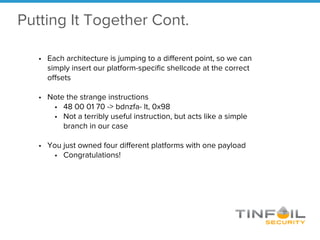One Shellcode to Rule Them All: Cross-Platform Exploitation
- 1. One Shellcode To Rule Them All.
- 2. Who are we • Michael “Borski” Borohovski • Co-Founder / CTO @ Tinfoil Security • Member of “Samurai” CTF team • MIT Computer Science • Hacking since 13, won Defcon 20 CTF • Shane “ShaneWilton” Wilton • Engineer @ Tinfoil Security • Member of “Samurai” CTF team • University of Waterloo Computer Science • Hacking since he was just a wee little baby
- 3. Who are we • Best web application scanner on the market • Focused on Dev. and DevOps integrations • Empower developers to find and fix vulnerabilities before they’re deployed • Enable security teams to focus on the hard problems • Email secuinside@tinfoilsecurity.com for 2 free months
- 4. What is shellcode? • Small piece of (assembled) code used as payload to exploit a vulnerability • Common goals • Launch a shell • Read a file • Stage a larger payload • ??? • Lots of public examples of shellcode • Shell-storm, metasploit, etc.
- 5. Why write your own? • Often you need to perform unique actions. • Unlock a door, call out to a different binary, etc. • May have unique constraints • Can’t contain the $ character • Only alphanumeric characters • Runs under both little and big endian (Dalvik?) • Fun!
- 6. How do you write shellcode? • Learn the system calls for your platform • Man pages are your friend • Start simple, then build more complexity • First, just call the _exit syscall • Then, “hello world” followed by _write followed by _exit • … • Familiarize yourself with different calling conventions • x86 - cdecl, fastcall, etc. • PowerPC - registers • SPARC - register windows ● Have fun with this one, because we didn’t • Most importantly…
- 7. How do you write shellcode? • Comment • Comment • Comment • Commenting with ; is your best friend • If you think understanding your Ruby code a month later is tough, try deciphering shellcode you’ve optimized to fit into a tiny buffer
- 8. Why is multiplatform shellcode useful? • Deploy once, pwn always • Consider the recent futex bug • Allowed for priv. esc. on linux • The original proof of concept (PoC) was for x86 • Geohot used the bug to root an android phone (ARM) • Theoretically, a multi-platform payload could root any linux device • Difficult to probe architectures in the wild • Same version of software can run on completely different architectures • Common with routers, smart devices, etc. • Guess wrong, and the target crashes • Crashes lead to detection
- 9. Why is multiplatform shellcode useful? • Malware (but that’s bad, don’t do it!) • Internet of things – everything connected, built differently, lots of cheap hardware choices • “100,000 Refrigerators and other home appliances hacked to perform cyber attack” • Internet census 2012 attacked 1.2M devices • Exploit/binary targeted 9 different platforms/architectures.
- 10. Compiling your pieces • QEMU or Virtual Machine (VMWare, Parallels, etc.) • Write shellcode once • Load image for desired architecture in QEMU • qemu-img create -f qcow2 linuxppc.qcow2 5G • qemu-system-ppc -hda linuxppc.qcow2 -cdrom debian-ppc.iso -boot d -m 512 • Use nasm to assemble once in qemu • nasm –f bin shellcode.asm
- 11. Compiling your pieces • Capstone • Programmable disassembly framework • http://www.capstone-engine.org/ • Arm, Arm64 (Armv8), Mips, PowerPC, SPARC, SystemZ, XCore & Intel • Written in C but bindings for Ruby, Python, etc. • Useful for seeing how opcodes disassemble in different architectures • Same opcode under different architectures lead to different behaviors • Take shellcode, print out disassembly for ARM, PPC, X86, etc.
- 12. • Different architectures require different payloads • Each architecture has its own nuances • x86 has variable length instructions • SPARC has fixed-length 32-bit instructions • Shellcode must not crash on any platform • We have three goals • Write payloads for each architecture • Determine the architecture of the CPU • Jump to the payload for that architecture • How do we determine the architecture of the CPU? Multi-Platform Payloads
- 13. • The same bytes decode to different instructions on different architectures • A jump instruction on x86 might be a NOP on PowerPC • Example - “x37x37xebx78” • x86 • aaa; aaa; jmp 116+4 • MIPS • ori $s7, $t9, 0xeb78 • SPARC • sethi %hi(0xdfade000), %i3 CPU Switch Header
- 14. • Needs to jump in one architecture, and be NOP-like in all others • Can’t crash any architectures • Can’t modify PC • We don’t care about most other register state • Most architectures encode branch instructions in predictable formats. • SPARC - 00-a-bbbbb-010-<22-bit offset> • a - 1-bit annulment flag • bbbbb - 5-bit condition • We can fuzz all of the possible branch instructions! Finding “switch” instructions
- 15. • Compute all of the branch instructions for an architecture • Use Capstone to decode them in all other targeted architectures • Look for instructions which decode harmlessly in most other architectures • Easier than it sounds! • We structure our switch-table like an onion • “Peel” off an architecture with each instruction • i.e. an instruction can’t crash MIPS, if MIPS has already jumped to its payload by that point Choosing Jump Candidates
- 16. • Consider the case on two architectures, A and B • Let IA and IB be the sets of possible branch instructions for A and B • IA = {a1 , a2 , a3 } • IB = {b1 , b2 , b3 } • Let Din be the set of dependencies for instruction in • i.e. if a1 crashes on architecture B then Da1 = IB • We need an instruction from IA and an instruction from IB such that there exists an evaluation order which resolves all dependencies • Called a topological ordering on the dependency graph Dependency Resolution
- 17. 1. Let S be the cartesian product of the sets of branch instructions 2. For each s ∈ S = (a, b, c, …) a. Construct a graph G with vertex set given by the elements of s b. Create a directed edge from vertex i to vertex j if instruction i crashes under the architecture for which j originates from c. Check for a topological ordering on G i. If one exists, return it, we are done ii. Otherwise, continue 3. If no ordering exists, we need to be clever a. Consider multi-stage payloads which split the targeted architectures into more manageable groupings Algorithmically…
- 18. • Polyglot @ DEFCON 22 CTF Quals • Construct a payload which reads a flag on x86, ARMEL (little endian), ARMEB (big endian), and PPC • The dependencies are resolvable as: • x86 -> PPC -> ARMEB -> ARMEL • tsort can do most of this work from the command-line! Putting It Together 73 12 00 00 48 00 01 70 9A 00 00 40 13 00 00 EA x86 jae 0x14 - - - PPC andi r1, r0, 72 bdnzfa- lt, 0x98 - - ARMEB tstvc r2, #0 stmdami r0, ... bls 0x110 - ARMEL ... ... ... b 0x60
- 19. • Each architecture is jumping to a different point, so we can simply insert our platform-specific shellcode at the correct offsets • Note the strange instructions • 48 00 01 70 -> bdnzfa- lt, 0x98 • Not a terribly useful instruction, but acts like a simple branch in our case • You just owned four different platforms with one payload • Congratulations! Putting It Together Cont.
- 20. • Hardware is becoming more and more varied, and will only get further fragmented over time • Knowing and being able to fingerprint one architecture will become a thing of the past • Writing one payload that works across many architectures was once a luxury, but is quickly becoming a requirement for launching attacks in the wild To sum it all up
- 21. • Basic idea: set up a jump table at the beginning of your shellcode, with one architecture falling through with each instruction • Find jmp/branch instructions in one architecture that are NOPs or NOP-like instructions in all others you’re targeting • To automate this search, you can reduce the problem to one of dependency resolution To sum it all up
- 22. 감사합니다





















